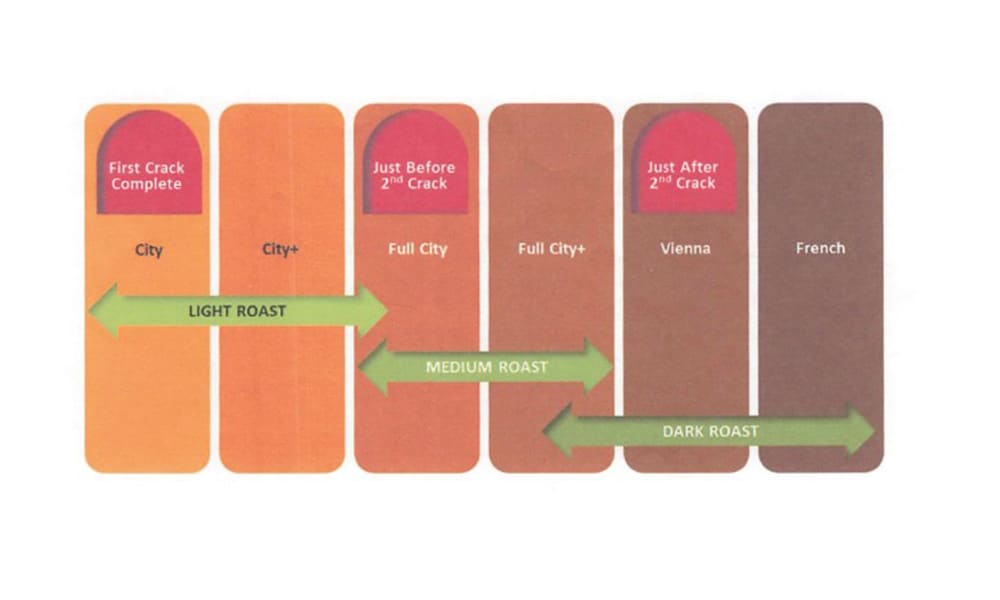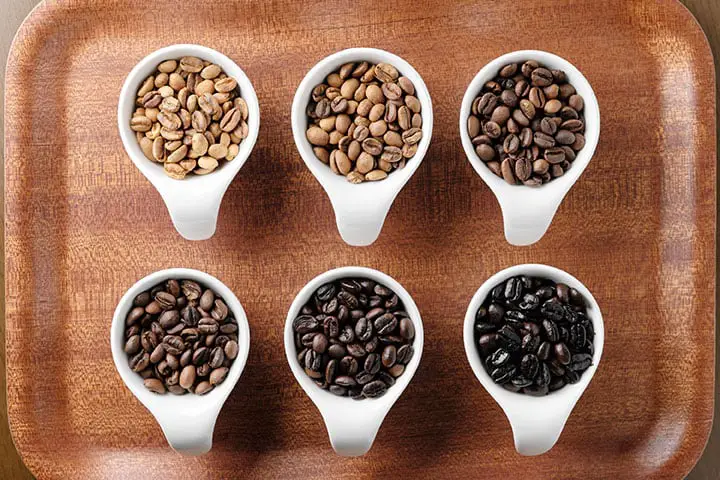
What do you say we begin an exciting journey to uncover the perfect roast profile for your coffee beans—a process as delightful as tasting that first morning sip. With no universal standard for roast profiles and every roaster adding their unique twist, coffee roasting is a playground for enthusiasts and casual drinkers alike. Whether you’re a seasoned coffee aficionado or just dipping your toes into the world of specialty brews, understanding roast levels can transform your coffee experience.
In this guide, I’ll look into the art of coffee roasting, exploring the spectrum from light to dark roasts. Each level brings its own distinct taste, aroma, and personality to the cup. I’ll break down how roasting impacts the coffee’s body, acidity, flavor, and even caffeine content, empowering you to pick the roast that matches your palate. From the bright, fruity notes of a City Roast to the bold, smoky punch of a French Roast, this is your roadmap to mastering the rich, diverse tapestry of coffee roasts.
What Are Coffee Roast Levels, Anyway?
Coffee roast levels generally fall into four main categories: Light, Medium, Medium-Dark, and Dark. These categories hinge on how long and how hot the beans are roasted, which shapes their flavor, color, and texture. The roasting process is where the magic happens—green coffee beans, which taste grassy and mild on their own, transform into the tasty brown gems we know and love. But the degree of roasting doesn’t just change the color; it shifts everything from acidity to body, making each level a unique experience.
Light roasts are all about showcasing the bean’s natural character—think vibrant acidity and delicate, fruity flavors. Medium roasts strike a balance, blending the bean’s origins with subtle roast-induced sweetness. Medium-dark roasts lean richer, with a fuller body and bolder notes, while dark roasts take center stage with smoky, hearty flavors that often overshadow the bean’s original profile. These categories can vary slightly depending on the roaster, but they’re the foundation for understanding what’s in your cup.
Breaking Down the Roast Levels
Light Roasts: The Bright and Lively Option
Light roasts, like the City Roast, are where the bean’s origin shines brightest. Roasted to around 356–425°F, these beans are pulled just after the “first crack”—a popcorn-like popping sound that marks the start of flavor development. The result? A light brown bean with a matte finish, no oil on the surface, and a crisp, tea-like body. Expect higher acidity here, which brings out floral, citrus, or berry notes, depending on where the coffee’s from.
City Roasts, typically hitting 412–425°F, are a favorite for coffee cupping (the pro way to taste coffee) because they reveal the bean’s true personality without much roast interference. However, if not roasted just right, they can taste sour or underdeveloped. If you love a thinner-bodied coffee with delicate, complex flavors, light roasts are your go-to.
Medium Roasts: The Balanced Crowd-Pleaser
Step up to medium roasts, like City+ or Breakfast Roast, and you’re in the sweet spot—literally. Roasted between 425–435°F, these beans cook a bit longer after the first crack, landing at a medium brown hue with a dry surface. The extra heat mellows the acidity and introduces caramelized sugars, giving you a fuller body and flavors like milk chocolate, nuts, or subtle fruit (think plum rather than lemon).
This roast, often called the “American Roast” for its popularity in the U.S., is versatile and approachable. It’s bold enough to satisfy dark-roast fans but still highlights the bean’s origins. If you’re after a smooth, well-rounded cup that’s not too intense, medium roasts are the Goldilocks choice—just right.
Medium-Dark Roasts: Rich and Robust
Enter medium-dark territory with roasts like Full City or Vienna, hitting 435–445°F. You’re now at or just past the “second crack”—a quicker, sharper sound signaling deeper roast development. The beans turn a richer brown, sometimes showing tiny oil flecks, and deliver a heavier body with muted acidity. Flavors shift toward bittersweet chocolate, toasted nuts, or even a hint of spice, making this a great pick for espresso or French press lovers.
Full City+ takes it a step further, edging closer to dark roast territory with a slightly shinier surface and bolder taste. These roasts balance roast-driven depth with traces of the bean’s character, offering complexity without going full-on smoky. It’s perfect if you want richness without losing all nuance.
Dark Roasts: Bold and Smoky
Dark roasts, like the famous French Roast, crank the heat to 445–465°F, well into or beyond the second crack. The beans emerge dark brown to nearly black, glistening with oils, and pack a punch with low acidity and a thick, full body. Here, the roast takes over—think smoky, bittersweet vibes with notes of dark chocolate, charred wood, or spice. The bean’s origin flavors? Mostly roasted out, making dark roasts consistent and bold across different coffees.
French Roast, a dark roast icon, often flirts with 465°F, delivering that signature smoky bite. Although this is my least favorite roast level, If you love a hearty, in-your-face coffee that pairs well with milk or this may be what you’re looking for. Just don’t expect much flavor—it’s all about the roast here.
First Crack vs. Second Crack: The Roasting Milestones
Roasting coffee is a trip for the senses, and two key moments—first crack and second crack—shape every roast level. The “first crack” hits around 390–410°F, sounding like popcorn popping as the beans expand and release steam. This is where light roasts like City stop, locking in bright, fruity flavors and high acidity. It’s the turning point from green to roasted, revealing the bean’s natural character.
Then comes the “second crack” at 440–450°F, a quicker, shallower snap like Rice Krispies in milk. Here, the bean’s cellular structure breaks down, oils surface, and flavors deepen. Medium-dark roasts like Full City catch its start, while dark roasts like French ride it out for that bold, smoky punch. These cracks are the roaster’s cues—whether you hear them or not, they define your cup’s taste, body, and soul.
How Roast Levels Affect Your Coffee
Roasting doesn’t just change flavor—it reshapes the whole experience. Here’s a quick rundown:
- Flavor: Light roasts keep it fruity and floral; medium roasts add sweetness and balance; medium-dark roasts go rich and bittersweet; dark roasts bring smoke and boldness.
- Acidity: High in light roasts (think zesty), moderate in medium, low in medium-dark, and nearly gone in dark.
- Body: Light roasts feel thin and crisp; medium roasts step up to smooth; medium-dark get full; dark roasts are heavy and syrupy.
- Aroma: Citrus and flowers for light, nuts and caramel for medium, spice and chocolate for medium-dark, smoky and earthy for dark.
- Caffeine: Light roasts retain the most, dark roasts the least—but the difference is small per bean. (Brew method and grind size matter more for caffeine kick.)
Check out this handy table to see it all at a glance:
| Roast Level | Temperature (°F) | Color | Flavor Profile | Acidity | Body | Best For |
|---|---|---|---|---|---|---|
| Light (City) | 356–425 | Light brown, matte | Fruity, floral, bright | High | Light | Pour-over, drip |
| Medium (City+) | 425–435 | Medium brown, dry | Nutty, sweet, balanced | Moderate | Medium | All-purpose, cold brew |
| Medium-Dark (Full City) | 435–445 | Rich brown, slight oil | Bittersweet, rich, spicy | Low | Full | Espresso, French press |
| Dark (French) | 445–465 | Dark brown/black, oily | Smoky, bold, chocolatey | Very low | Heavy | Espresso, lattes |
Picking Your Perfect Roast
So, how do you choose? It’s all about what you crave. Love a zingy, fruit-forward cup? Stick with light roasts and a pour-over setup. Prefer something smooth and versatile? Medium roasts have you covered. Craving depth and richness? Medium-dark fits the bill. Want a bold, no-nonsense brew? Dark roasts deliver.
Experimentation is key—try different roasts from various regions (Ethiopian light roasts for floral vibes, Colombian medium for balance, Indonesian dark for earthiness). Pair them with brewing methods to unlock their full potential. And don’t sweat the roaster’s fancy names—focus on the core levels and taste what clicks.
Wrapping It Up
Coffee roasting is an art form, turning humble green beans into a spectrum of flavors that cater to every taste. Whether you’re sipping a delicate City Roast or a robust French Roast, the roast level shapes your coffee’s soul. Now that you know the differences—flavor, acidity, body, and all—you’re ready to explore with confidence. So grab a bag of beans, brew a cup, and let your taste buds lead the way.

